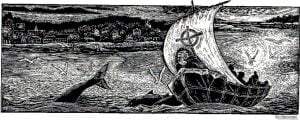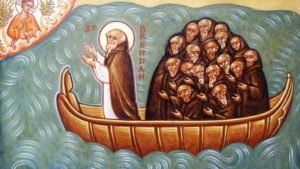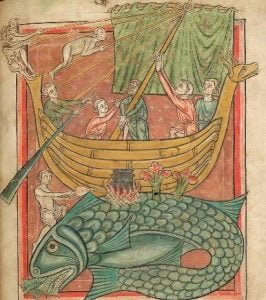
St. Brendan the Navigator is a character of great importance to the history of exploration. His adventures led him far abroad in a time when maps were rare and inaccurate, the seas were full of mystical creatures and massive monsters, and safe return rested solely in the hands of God. His exploits helped shape the future of exploration for hundreds of years after his death, and perhaps even helped lead to the age of discovery.
Born in Ireland circa 485 A.D., he was a leader among his society. As a Catholic Priest he founded several monasteries in Ireland. Very little hard fact is known about Brendan, but it’s clear by the stories that survive that he was an uncommonly great man. What we do know comes from Irish genealogies, oral traditions, and two Latin poems; the Navigatio Sancti Brendani and the Vita Sancti Brendani. These stories were repeated over and over throughout history. Reinforcing the importance of pious beliefs, and no doubt inspiring many to answer the call of adventure.
Taking a step back into the past, we see that European history was fraught with warfare both within the Catholic church and between the major governments of the time. The Carolingian Empire was at war with itself and Rome. The Iberian Peninsula was being overrun by the Moors. Rome was holding onto a tiny piece of it’s original empire, and the Byzantine Empire, now separate from Rome, was the main superpower to the east. The Catholic Church was trying to hold everything together, expel Islam, and create a secure future for itself. Add to this mess; roving bands of Norsemen from Scandinavia and horsemen from the steppes, all vying for lands across Europe, and you have a world where it’s hard to survive. During this time, Ireland was a remote safe haven for Christian culture. Relatively unmolested and isolated from the drama to the east, the Christians of Ireland guarded and expanded European Christian culture through education and exploration.
Enter St. Brendan. In this time of turmoil, Brendan sought peace through serving God. He set out on a seven year voyage to find the Land of Promise of the Saints in the seas north and west of Ireland. It is unclear, as no certain record shows the actual travels and destinations of St. Brendan, however, scholars believe that he had reached Brittany, the Orkney islands, Hebrides, Faroe, and the Shetland Islands. Some even arguing that he and his followers may have reached present day Iceland, Greenland, and even Newfoundland.
Fortunately, we’re not here to speculate destinations and times. Instead we will enjoy the adventure as it is recorded while understanding and comparing it to the culture and philosophy of the times. It is interesting though, as St. Brendan’s accounts are recalled, to make comparisons with things we are familiar with today. After heading North for three days, Brendan and his monks come to a complete calm where; “the sea became like a thick curdled mass”. Could this refer to pack ice in the Northern seas? While passing an island shrouded in thick smoke, they are assailed with molten metal and rocks thrown by giant native blacksmiths. At this point, Brendan explains to his men that they have crossed into the realm of Hell. Perhaps a volcano erupting on Iceland? Another instance, they find a massive tower of crystal jutting from the sea. After inspection they are still unable to identify the mass. Could this have been an iceberg?
To set the stage for this epic adventure, it’s important to put yourself in the shoes of a person living in the same time and place. Consider the daunting task of setting out to sea in a small boat. Couple that with the simple fact that the territory beyond the horizon is relatively unknown. In reality, very few people have attempted long journeys upon the open sea, and fewer lived to tell of it. The technology used to make boats and navigate is primitive; mostly relying on natural materials readily at hand and trusting to stars and weather patterns for direction. Maps of the time reflect more upon religious importance, rather than geographical accuracy. Northern climates with their ripping icy winds, and stinging sea spray make travel in an open boat utterly miserable. Meager provisions consist of hard baked bread and salted dried meats. When the task seems nearly impossible, even if you survive the exposure, survive the sea’s constant attempts to destroy your boat, and survive the torment of an unsuitable diet, imagine holding the belief that out upon the unknown seas dwell massive and malicious monsters so abundant that you are nearly guaranteed to encounter them. As a monk under St. Brendan, respite lies in your confidence of your leader and your trust in God to deliver you from harm. With this in mind, let’s follow St. Brendan on his quest.
Stories begin with St. Brendan speaking with an old hermit, Barinthus. Barinthus describes lands to the west, and the adventures that befell him while on his holy pilgrimage. He ends with a description of the Land of Promise of the Saints; where there is no darkness, no hunger, and no need for sleep. As it was explained to Barinthus; the island is a literal Garden of Eden, where Jesus Christ is the light, and if men had not transgressed the commandments they would have always dwelt there.
This was the beginning of Brendan’s travels. What comes afterward seems strange and magical, but keep in mind the importance and wide acceptance of the mystical, the magical, the utter devotion to religious beliefs, and the simple fact that much of the world was a mystery and could only be explained by these circumstances. The maps of the time were called mapamundi, translated from Latin; “map of the world”. Mapamundi were not geographically accurate, not scaled, and often showing monsters and representing lands and things that did not exist. What these maps did represent, following the same line as Brendan’s stories, are things that are religiously important. These maps are oriented with East in the up position and centered over Jerusalem. East being the direction which paradise was supposed to lie, a place where no man could go. Following this trend of religious devotion, magical experiences, and mystical explanations, Brendan sets out on a seven year voyage toward the unknown Land of Promise of the Saints. He leaves with no more certainty than having ultimate and unending trust in God.
If you take the time to read Brendan’s voyages you will note the abundance of strong Christian symbolism embodied in rituals, sacred numbers; 3,7,14,40 etc., and explanations for unknown events. It becomes very clear that these stories are rather more about teaching the importance of piety than an accurate account of travel.
Brendan starts by selecting 14 monks. They build a boat from cow hides, which is a truly interesting process and relatively common in Ireland at the time. A skeletal frame would be created out of wood. Cow hides would be placed over the structure and stitched together with leather strips. The hides would be allowed to dry, and then tanned, shrinking down around the wooden skeleton. The seams were all caulked with tar, and a boat was formed. This sort of boat would take constant energy to keep it in tact; re-caulking seams, fixing tears, and watching for leaks. These men are taking on a journey that few people of the day could fathom, and they’re doing it in an open, keelless, leather boat. Nonetheless, they load up with supplies and embark.

During the first year of the voyage the group runs into several situations that test their faith. Although nothing is mentioned about their conditions aboard the boat or the specific challenges that they must daily overcome, it must be supposed that life in an open boat was brutally harsh on the northern seas. At the close of the first year of their adventure they reach an island where they sail up a stream. At the headwaters of this stream is a large tree filled with beautiful white birds. Brendan prays to God to tell him what message is meant by the tree and birds. One of the great birds settles near him and begins to speak. It tells Brendan that he and the birds are fallen angels, and they come here to repent. He then makes an important prediction; he tells Brendan that he must repeat the circuit of the last year’s destinations for the next six years to come, in order to reach the Land of Promise of the Saints. So, for the next six years, Brendan and his followers revisit the destinations experiencing many more adventures, always trusting to God and always preserved by divine intervention.
During their travels they see many strange lands. First, an island of giant sheep where a mysterious man shows them hospitality and continues to replenish their stores throughout the journey. It is often speculated that Brendan may have landed at the Faroe Islands. In fact, the name Faroe is derived from the Norse title Færeyja, meaning Sheep Islands.
Leaving the island of giant sheep, they come across a monastery of monks who have taken a solemn oath of silence. The monks are fed by the good grace of God, who miraculously provides them with half a loaf of bread for each man every day. From the story, it seems that this bread appears from thin air, and is even increased to one loaf per man on feast days. At dusk in this monastery, a flaming arrow goes through the hall, lighting the lamps which never run out of oil. These monks are marked by and rewarded for their literal trusting to God to provide for them.
Stopping at an island nearby to celebrate Easter, Brendan neglects to leave the boat while the others are preparing. Upon lighting a fire to prepare the feast, the island begins to quake and move. All the monks are helped back into the boat by Brendan. They watched as the island and their fire recede over the horizon. Brendan then explains that they had landed on the back of a giant fish. Sound familiar? You will find similar stories in the Bible, and in the Thousand and One Nights sagas. They return to this fish every year to celebrate Easter. It seems that he’s fine with them visiting, just not setting fires on his back.

During this period of six years, the monks are attacked by a giant sea creature and a gryphon, half eagle, half lion. In both instances they are saved in the very last moment by another creature sent by God to do battle with the attacker. In both instances, St. Brendan is portrayed as a stoic figure, encouraging his followers to believe in the will of God for protection. God seems to have prevailed even to this day, since gryphon attacks are at an all-time low.
They find an island covered in smoke and fire, where the inhabitants throw molten metal and giant rocks at them. Brendan takes this as a sign that they have entered the region of Hell. It’s intriguing to think that perhaps the native giant blacksmiths hurling molten metal at them may have been an erupting volcano. During this period too, they find a giant tower of crystal in the sea. They spend time exploring this formation, but don’t seem to come to any conclusions. Glacial icebergs cut a good image when described as giant towers of crystal. Don’t you think?
After six years of exploration, returning to the destinations necessary to complete their quest, they find themselves again at the island of the fallen angels. Here they are approached by their benefactor from the Island of the Sheep. This man tells Brendan that he will lead them to the Land of Promise of the Saints. Why he couldn’t do this six years ago? Brendan and his crew find that out at the climax of their journey. Venturing for 40 days, they finally reach the Land of Promise of the Saints. In this land there is no darkness, fruits, vegetables, and herbs grow in abundance, and the stones were all precious gems. After their long arduous journey, this must have really been a paradise. They explored this land for 40 days, finally reaching a river that could not be crossed. Here a young man approached them and explained all. He said that this was the place St. Brendan had been seeking for the last seven years, explaining that God had wanted to show Brendan the diverse mysteries of the ocean. The young man then orders Brendan to go home and be reunited with his saintly brethren. The story abruptly ends when St. Brendan returns home. It seems he told his stories, lived the rest of his life quietly, and died at his monastery.
The stories of St. Brendan’s voyages have piqued the interest of explorers throughout history. Until the wider “Voyages of Discovery” in the 15th century, many of Brendan’s observations were hailed as truth. These observations included sea monsters, islands of demons and of angels, and other islands that mysteriously vanished. These disappearing islands, appropriately called false islands, were observed and noted once, occasionally to be spotted later, sometimes never to be observed again. It just goes to show the power that mystery, curiosity, and adventure has over our human minds.
Although by today’s standards, the Voyages of St. Brendan are rather farfetched and viewed more as pious bedtime stories or just tales from the middle ages, his stories had a far reaching effect that eventually helped to overturn a paradigm of exploration. Sailors began to reach out, instead of sailing coastal waters, they began to explore the Atlantic. It is said that many early explorers, even Christopher Columbus himself, took the stories more or less for fact. These explorers went as far as being surprised when they were never confronted by sea monsters or mysterious demons.
Although inaccurate, Brendan’s stories helped fuel further exploration into the Atlantic and beyond; leading to new discoveries, new technology for sailing and navigation, and an entire new breed of explorers. These explorers would change the way the world was viewed, Columbus, Magellan, Cook, and many others, would all add places and details to the map never before imagined by European and Asian societies. Adventures real or not, St. Brendan the Navigator has earned a place among the greatest explorers.
